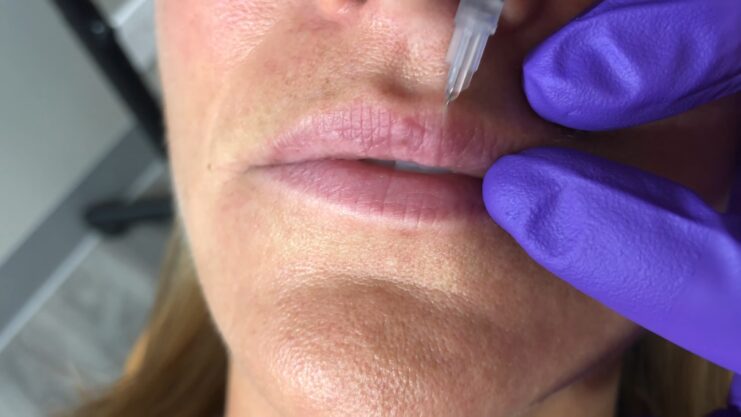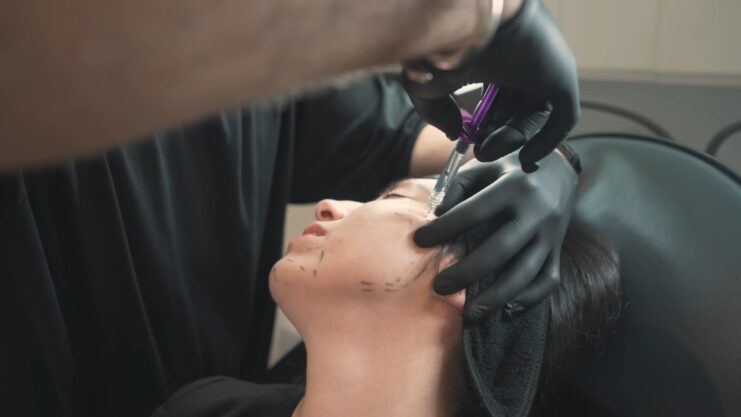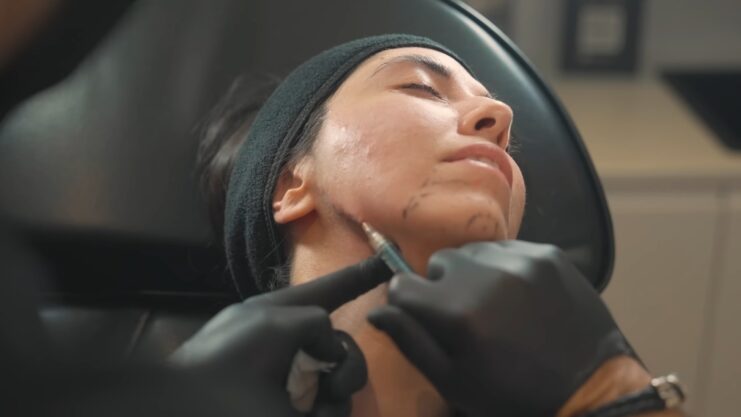Dermal fillers have emerged as a revolutionary treatment in the world of cosmetic dermatology, promising a youthful appearance by restoring volume and fullness to the skin. Exploring their types, benefits, precautions, and much more, to provide a comprehensive understanding of this innovative solution to aging.
The aging process leads to a gradual depletion of collagen and fat, causing the skin to sag and form wrinkles. Dermal fillers work by replenishing these lost elements, thereby restoring the skin’s youthful appearance. They come in varying viscosities, with thicker products being injected deeper to treat severe wrinkles and folds.
Types of Dermal Fillers
There are several types of dermal fillers available, each designed to address specific concerns and areas of the face. The most common types include hyaluronic acid fillers, calcium hydroxylapatite fillers, and poly-L-lactic acid fillers. Each type has its unique properties and is suitable for different treatment areas and purposes.
- Hyaluronic Acid Fillers: These are the most popular type of fillers, known for their ability to hydrate the skin and improve its texture and tone.
- Calcium Hydroxylapatite Fillers: These are thicker and are used to address deeper wrinkles and enhance cheekbones.
- Poly-L-lactic Acid Fillers: These stimulate collagen production and are typically used to treat deep facial wrinkles.
Pre-Treatment Precautions
Before undergoing dermal filler treatment, it is crucial to discuss any existing medical conditions, allergies, or medications with the practitioner. Individuals with known allergies to hyaluronic acid or those who have had reactions to previous filler treatments should avoid this procedure. Additionally, pregnant or breastfeeding women and individuals with autoimmune diseases like rheumatoid arthritis and psoriasis should consult their healthcare provider before opting for dermal fillers.
It is also vital to inform the practitioner about any history of cold sores or fever blisters, as the treatment may trigger an outbreak. Individuals with active acne or any infection in the treatment area should postpone the procedure until the condition resolves.
Medication and Lifestyle Considerations
Certain medications and lifestyle factors can impact the outcome of dermal filler treatments. Aspirin, painkillers, and isotretinoin are some medications that can interfere with the healing process and should be disclosed to the practitioner. Additionally, lifestyle factors like smoking and exposure to extreme temperatures can affect the treatment results and should be considered when planning the procedure.
- Avoid Aspirin and NSAIDs: These can increase the risk of bleeding and bruising at the injection site.
- Avoid Smoking: Smoking can delay healing and affect the longevity of the results.
- Avoid Extreme Temperatures: Exposure to intense cold or heat can denature the product and reduce the effectiveness of the treatment.
Potential Side Effects and Post-Treatment Care
Dermal filler treatments are generally well-tolerated, but some individuals may experience mild side effects such as redness, swelling, itching, and slight pain, which usually subside within 72 hours. Applying firm pressure with a clean piece of gauze can manage bleeding at the injection sites. Mild bruising may occur but typically fades after 3 to 5 days.
Rarely, some individuals may experience allergic reactions, prolonged redness, swelling, or hardness and bumps in the skin, which can last for several months. In such cases, immediate medical attention is necessary to manage the symptoms and prevent any long-term complications.
Post-Treatment Recommendations
After receiving dermal fillers, it is recommended to avoid massaging the treated area for 12 hours and to refrain from applying makeup or attending facials, as this may displace the product. Laser or IPL treatments and exposure to extreme temperatures should be avoided for 1 week post-treatment to preserve the product’s integrity.
- Immediate Return to Work: Most people can resume their normal activities immediately after the treatment.
- Follow-Up Appointments: These are essential to assess the results and determine if additional enhancement injections are necessary.
- Top-Up Treatments: Depending on the type of filler used, top-up treatments every 3 to 6 months are required to maintain the effect.
Dermal Fillers for Lips

The allure of full, well-defined lips is undeniable, and dermal offer a solution to those seeking to enhance their lip volume and shape. Age, sun damage, and lifestyle choices like smoking can cause the lips to lose their plumpness and turn inwards. Dermal fillers can restore this lost volume and even shape the lips to create a desirable and subtle French pout.
Lip augmentation with dermal is a meticulous process, requiring a thorough understanding of lip anatomy and aesthetics. The practitioner must consider the individual’s facial features, lip symmetry, and personal preferences to achieve natural-looking and harmonious results.
Lip Filler Materials and Techniques
Various materials and techniques are used in lip augmentation, with hyaluronic acid fillers being the most popular due to their safety and efficacy. These fillers offer temporary results, allowing individuals to modify their lip appearance over time. The injection technique and filler placement are crucial in achieving the desired outcome and avoiding complications.
- Material Selection: Hyaluronic acid fillers are preferred for their reversible and customizable nature.
- Technique Mastery: The injector’s expertise determines the success of the treatment, ensuring balanced and refined results.
Enhancing the Nose Bridge with Fillers
For individuals desiring a more pronounced nose bridge, dermal fillers offer a non-surgical alternative to rhinoplasty. This procedure is especially popular among Asians, where a defined nose bridge is often sought to enhance the facial profile and draw attention to the eyes. Dermal fillers can elevate the nose bridge and, when combined with a brow lift, can significantly enhance the overall facial appearance.
The non-surgical nose reshaping procedure requires precision and an artistic eye to ensure that the results are symmetrical and complement the individual’s facial features. It is a minimally invasive option with little to no downtime, making it a preferred choice for many.
Procedure and Results
The procedure involves injecting dermal fillers into the nose bridge to achieve the desired height and definition. The results are immediate, and the procedure can be tailored to meet the individual’s aesthetic goals. However, it is essential to have realistic expectations and to choose a qualified and experienced practitioner to avoid complications and achieve optimal results.
- Immediate Satisfaction: The results are visible right after the procedure, offering instant gratification.
- Customization: The procedure can be adjusted to suit individual preferences and facial features.
Longevity and Maintenance

The longevity of dermal fillers depends on the type of filler used, the area treated, and individual metabolic factors. Generally, hyaluronic acid lasts between 6 to 12 months, while other types of fillers may offer more prolonged results. Regular follow-up appointments are essential to assess the longevity and to plan for maintenance treatments if necessary.
Maintaining a healthy lifestyle, avoiding excessive sun exposure, and adhering to a skincare regimen can enhance the longevity of dermal fillers. Regular touch-up treatments can help maintain the desired appearance and address any changes in facial anatomy due to aging.
Maintenance Treatments
Maintenance treatments are crucial in sustaining the results of dermal. These treatments are typically less extensive than the initial procedure and are focused on addressing any loss of volume or changes in facial contours that occur over time. It is essential to schedule maintenance treatments proactively to ensure seamless and consistent results.
- Proactive Approach: Scheduling maintenance treatments before the effects of the initial treatment diminish is key.
- Consistency is Crucial: Regular treatments help in maintaining a stable and enduring youthful appearance.
Choosing the Right Practitioner

Choosing a qualified and experienced practitioner is paramount in achieving successful dermal filler treatments. A knowledgeable practitioner will conduct a thorough consultation to understand the individual’s concerns, medical history, and aesthetic goals. They will also provide realistic expectations, recommend suitable treatment options, and develop a personalized treatment plan.
The practitioner’s expertise in injection techniques, knowledge of facial anatomy, and aesthetic judgment are crucial in avoiding complications and ensuring natural-looking results. It is advisable to research and choose a practitioner with a proven track record and positive reviews.
Consultation and Personalized Treatment Plan
A detailed consultation is the first step in the dermal filler journey. It allows the practitioner to assess the individual’s facial features, skin condition, and aesthetic desires. Based on this assessment, the practitioner will propose a personalized treatment plan, outlining the recommended types, treatment areas, and expected outcomes.
- Open Communication: A transparent and open dialogue between the practitioner and the patient is vital.
- Individualized Approach: A tailored treatment plan addresses individual concerns and desires effectively.
FAQs
Can they be used to treat areas other than the face?
Yes, dermal fillers can also be used to treat other areas of the body, such as the hands, to reduce the appearance of veins and tendons, and to correct volume loss.
Are they suitable for all skin types?
Dermal fillers are generally suitable for all skin types; however, individuals with certain skin conditions or allergies should consult with a practitioner to determine the most suitable treatment.
Can they be dissolved if I am unhappy with the results?
Yes, hyaluronic acid-based fillers can be dissolved using an enzyme called hyaluronidase, allowing for corrections or adjustments to be made.
Is there any downtime after receiving dermal fillers?
Typically, there is minimal to no downtime, and most individuals can return to their normal activities immediately after the procedure.
Can I combine with other cosmetic treatments?
Yes, dermal fillers can be combined with other treatments such as Botox, chemical peels, and laser therapy, depending on individual needs and treatment plans.
How much do they cost?
The cost of dermal fillers varies depending on the type of filler, the amount used, and the practitioner’s experience. It is essential to prioritize quality and safety over cost when considering dermal fillers.
Are the results permanent?
The results of dermal fillers are temporary, and their longevity depends on the type of filler used and individual metabolic factors. However, some semi-permanent and permanent fillers are also available.
Final Words
Dermal fillers stand as a beacon of innovation in the realm of cosmetic dermatology, offering a non-surgical solution to the inevitable signs of aging. They empower individuals to regain their youthful radiance and confidence by addressing various aesthetic concerns, from enhancing facial contours to revitalizing skin texture. The journey is deeply personal and transformative, requiring informed decisions, qualified practitioners, and a commitment to maintaining the achieved results. Embrace the journey, and let the transformative power of dermal fillers unveil your timeless beauty!












